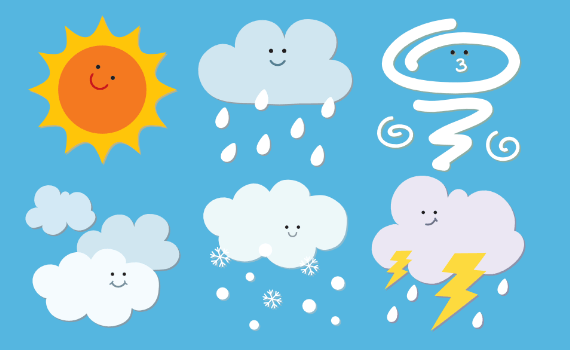
Weather

Natural Disasters

Experiments

Kid's Zone
Lightning
- Lightning Questions
- Types of Lightning
- Lightning Definitions
- Lightning Facts
- Lightning Safety
- Lightning Activities
What is lightning?
Lightning is a bright flash of electricity produced by a thunderstorm. All thunderstorms produce lightning and are very dangerous. If you hear the sound of thunder, then you are in danger from lightning. Lightning kills and injures more people each year than hurricanes or tornadoes; between 75 to 100 people.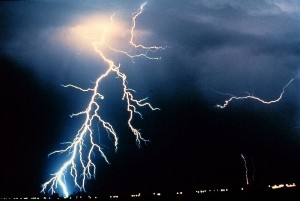
What causes lightning?
Lightning is an electric current. Within a thundercloud way up in the sky, many small bits of ice (frozen raindrops) bump into each other as they move around in the air. All of those collisions create an electric charge. After a while, the whole cloud fills up with electrical charges. The positive charges or protons form at the top of the cloud and the negative charges or electrons form at the bottom of the cloud. Since opposites attract, that causes a positive charge to build up on the ground beneath the cloud. The grounds electrical charge concentrates around anything that sticks up, such as mountains, people, or single trees. The charge coming up from these points eventually connects with a charge reaching down from the clouds and – zap – lightning strikes!
Have you ever rubbed your feet across carpet and then touched a metal door handle? If so, then you know that you can get shocked! Lightning works in the same way.
Click Here to see where lightning is currently striking across the U.S.
How hot is lightning?
Lightning is approximately 54,000 degrees Fahrenheit. That is nearly six times hotter than the surface of the sun!
What causes lightning to be colored rather than the usual white or blue?
Lightning can appear to be many different colors depending on what the light travels through to get to your eyes. In snowstorms, where it is somewhat rare, pink and green are often described as colors of lightning. Haze, dust, moisture, raindrops and any other particles in the atmosphere will affect the color by absorbing or diffracting a portion of the white light of lightning.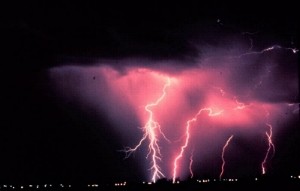
What are cloud flashes?
A cloud flash is lightning that occurs inside the cloud, travels from one part of a cloud to another, or from the cloud to the air.
What is a “stepped leader”?
A stepped leader is a stream of weakly charged particles that flows from the cloud – it moves towards the ground, starting and stopping, and sometimes branching, trying to find the path of least resistance.
Is it possible to have thunder without lightning?
No, it is not possible to have thunder without lightning. Thunder is a direct result of lightning. However, it IS possible that you might see lightning and not hear the thunder because it was too far away. Sometimes this is called “heat lightning” because it occurs most often in the summer.
Is lightning always produced by a thunderstorm?
Thunderstorms always have lightning (thunder is caused by lightning, and you can’t have a thunderstorm without thunder), but you can have lightning without a thunderstorm. Lightning can also be seen in volcanic eruptions, extremely intense forest fires, surface nuclear detonations, and in heavy snowstorms.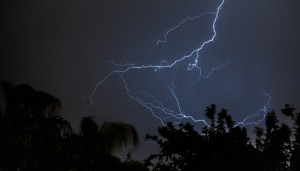
What causes thunder?
Thunder is caused by lightning. When a lightning bolt travels from the cloud to the ground it actually opens up a little hole in the air, called a channel. Once then light is gone the air collapses back in and creates a sound wave that we hear as thunder. The reason we see lightning before we hear thunder is because light travels faster than sound!
How do you know if lightning is nearby?
If you see dark clouds, then lightning could be present, but the best thing you can do is to listen for thunder. If you hear thunder, then you need to go indoors or get in a car. Don’t be outside, where lightning could strike! If your hair stands on end or your skin starts to tingle, lightning maybe about to strike. Get down on your hands and knees and keep your head tucked in. Do not lay flat, because it can give lightning a better chance of strike you.
How far away can you see lightning and hear thunder?
Within those distant thunderstorms, the lightning bolts can be seen as much as 100 miles from us, depending on the height of the bolt, the clarity of the air, and our elevation. Thunder, in comparison, has a much shorter range of detection – usually less than 15 miles in a quiet rural setting and under 5 miles in a noisy city environment.
What is dry lightning?
Dry lightning is lightning that occurs without rain nearby. The NOAA Storm Prediction Center routinely forecasts dry lightning because this kind is more likely to cause forest fires.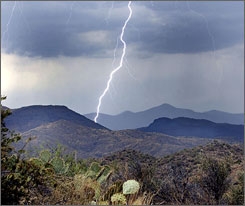
What is a “bolt from the blue”?
A “Bolt from the Blue” is a cloud-to-ground flash which typically comes out of the back side of the thunderstorm cloud, travels a relatively large distance in clear air away from the storm cloud, and then angles down and strikes the ground. These lightning flashes have been documented to travel more than 25 miles away from the thunderstorm cloud. They can be especially dangerous because they appear to come from clear blue sky.
How many volts and watts are in lightning?
Lightning can have 100 million to 1 billion volts, and contains billions of watts.
Why are positive lightning bolts deemed more dangerous than the more common negatively charged bolts?
Positive lightning is often considered more dangerous because its electrical field is stronger (forming at the top of the storm), the flash duration is typically longer, and its peak charge can be much greater than a negative strike. Plus, positively charged lightning can occur near the edge of a cloud or strike more than 10 miles away – when people aren’t aware of the danger.
Does lightning strike from the sky down, or the ground up?
The answer is both. Cloud-to-ground lightning comes from the sky down, but the part you see comes from the ground up. A typical cloud-to-ground flash lowers a path of negative electricity (that we cannot see) towards the ground in a series of spurts. Objects on the ground generally have a positive charge. Since opposites attract, an upward streamer is sent out from the object about to be struck. When these two paths meet, a return stroke zips back up to the sky. It is the return stroke that produces the visible flash, but it all happens so fast – in about one-millionth of a second – so the human eye doesn’t see the actual formation of the stroke.
Why are you less likely to see static electricity in the summer?
In the summer, our dew points are much higher due to warm and humid air coming from the Gulf of Mexico and that is why we have humid weather. In the winter, our dew points are much lower due to cold and direr air coming from Canada. The lower the dew point the better it is to create static electricity, so that’s why you see it more in the winter.
Can you tell how far away a storm is?
Yes, you can use thunder to tell how far away a storm is. Next time you see a storm, count the number of seconds between when you see the lightning and hear the thunder. Take the number of seconds and divide by 5 and that will tell you how far away the storm is in miles. For example: If you counted 10 seconds between the lightning and the thunder, the lightning is 2 miles away!
Does lightning happen during the winter?
Lightning occurs less frequently in the winter because there is not as much instability and moisture in the atmosphere as there is in the summer. During the winter, the land surface is cooler because there is not as much heating by the sun to warm it up. Warm air holds more water vapor. And, when water vapor condenses into liquid water cloud drops, latent heat is released which fuels the thunderstorm. So, warm, moist air near the surface (and the proper conditions aloft to give you lots of instability) can result in deep convection, which may produce lightning discharges. Clouds become electrified when strong updrafts (fueled by the instability and moisture) bring supercooled liquid water drops and ice crystals at temperatures less than freezing (0 deg C) together. In this environment, interactions between the ice crystals and supercooled water droplets produce electric charges. The exact mechanisms by which this charging happens remain unknown. The electrical charges build up until they are strong enough to overcome the resistance of the surrounding air. The breakdown of the electric fields produced by these charges is the lightning bolt.
What is thundersnow?
Although thunderstorms are less common in the winter, sometimes lightning can occur within snowstorms. Called thundersnow, relatively strong instability and abundant moisture may be found above the surface, such as above a warm front, rather than at the surface where it may be below freezing. Thundersnow is sometimes observed downstream of the Great Salt Lake and the Great Lakes during lake-effect snowstorms, too.
What happens to the ground when lightning strikes it?
What tends to happen when lightning strikes ground is that it fuses dirt and clays in to silicas. The result is often a glassy rock called a fulgurite in the shape of a convoluted tube. Fulgurite has been found all over the world, but is relatively rare. The color depends on the minerals in the sand that was struck.The shape in the ground is the shape of the path the lightning current followed in the ground. There is often damage to grasses along this path too.
What is fulgurite?
Fulgurite is brittle, glassy formations caused by a lightning strike to sandy soil. The lightning heats the soil and fuses the soil particles together surrounding the path of the channel, resulting in a hollow tube-like formation shaped like the section of lightning that formed it.
Does lightning always strike the tallest object?
Never say always! Lightning USUALLY strikes the tallest object. It makes sense that the tallest object is most attractive, because it is the easiest path for the lightning to take.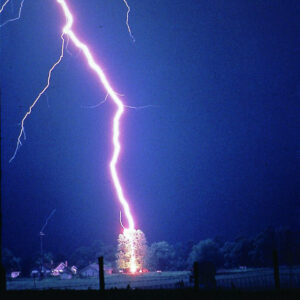
Can lightning strike the same place twice?
Yes, lightning does hit the same spot or almost the same spot more than once, contrary to folk wisdom. Taller objects are more likely than shorter objects to produce the upward channel. But it is also possible that something that locally affects the ability of the ground to conduct electricity such as the salt or moisture content of the ground at the time, the presence or absence of rock, standing water, pipes or other metal objects in the ground, the terrain shape, the shape of leaves or twigs, or something else might make a particular location more likely than another nearby location to be struck.
What is a lightning rod?
Lightning rods (also called conductors) are metal rods or similar objects that divert lightning safely to the ground, they can often be seen at the top of tall buildings.
What is volcanic lightning?
Volcanic lightning, also known as dirty thunderstorms, is capable of producing some of the most powerful and visually striking lightning storms on Earth. Not all volcanic eruptions produce lightning. When it does occur, a single eruption can create multiple, separate lightning storms. The lightning seems to be set off by explosions during the eruption, although not all explosions cause lightning. During recent eruptions that displayed lightning, scientists observed the most intense lightning occurred at the beginning of the eruption and gradually decreased as the eruption continued, sometimes over a period of weeks.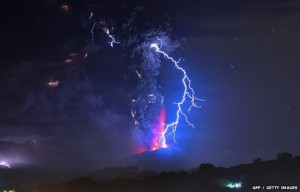
What is cloud-to-ground lightning?
All lightning is dangerous, but cloud-to-ground lightning is the most dangerous type of lightning. Most cloud-to-ground lightning strikes come from the negatively charged bottom of the cloud traveling to the positively charged ground below. Cloud-to-ground lightning bolts strike the tall objects, like trees and buildings. These lightning strikes can cause fire and property damage. If you’re the tallest object, then lighting can strike you. Lightning is the second weather related killed.
What is cloud-to-air lightning?
Cloud-to-air lightning is referred to a discharge or portion of a discharge jumping from a cloud into clear air. Technically speaking, all cloud-to-ground lightning strikes contain cloud-to-air components in the many branches that extend away from the main channel and terminate abruptly in mid-air. However, the most visually dramatic examples of cloud-to-air lightning occur when a long, bright lightning channel jumps out of the side of a cumulonimbus cloud and terminates in the clear air surrounding the storm.
What is intracloud lightning?
Intracloud lightning is the most common type of lightning. This occurs when there are both positive and negative charges within the same cloud. Usually, the process takes place within the cloud and looks like a bright flash of light which flickers.
What is intercloud lightning?
Intercloud lightning is less common. It’s when a lightning strike occurs when there are positive and negative charges within different clouds and the strike travels in the air between them.
What is an anvil crawler?
An anvil crawler is lightning that branches upward and outward like a tree along the tops and sides of large thunderstorms. The lightning seems to ‘travel’ or ‘crawl’ across the sky. Anvil crawlers are sometimes referred to as spider lightning.
What is forked lightning?
Forked lighting appears as jagged lines of light. They can have several branches. Forked lightning can be seen shooting from the clouds to the ground, from one cloud to another cloud, or from a cloud out into the air. This lightning can strike up to 10 miles away from a thunderstorm.
What is sheet lightning?
Sheet lightning appears as flashes of light that seem to light up or illuminate entire clouds.
What is heat lightning?
Heat lightning is a term used to describe lightning flashes that are too far away from you to hear the thunder. The reason that it is called heat lightning is that it appears most often on a hot summer day when the sky is clear overhead.
What is high-altitude lightning?
High-altitude lightning has been given other names such as “red sprites,” “green elves,” and “blue jets.” This form of lightning appears as brightly colored flashes, high above thunderstorms. You can’t see these types of lightning from the ground.
What is ribbon lightning?
Ribbon lightning is when a bolt of lightning separates due to wind and appears as parallel lightning streaks.
What is chain or bead lightning?
Chain or bead lightning is when a lightning bolt is broken into dotted lines while fading.
What is ball lightning?
Ball lightning is a rare form of lightning. It usually appears as a reddish, luminous ball, but can come in any color. Ball lightning is usually spherical in shape and about one foot in diameter. Hissing noises originate from such balls and they sometimes make a loud noise when they explode.
What is St. Elmo’s Fire?
St. Elmo’s Fire appears as a blue or greenish glow above pointed objects on the ground. It is created when tiny positively charged sparks reach up in response to negatively charges in the air or clouds above the ground. If a thunderstorm is nearby, St. Elmo’s Fire might be seen right before a lightning strike.
What is anvil lightning?
Anvil lightning is a type of lightning referred to as “the bolt from the blue” because it often appears suddenly from a seemingly cloudless sky. A bolt at the top of a thunderstorm arcs away from the main cloud and strikes the ground where the skies above often appear clear.
What is volcanic lightning?
Volcanic lightning, also known as dirty thunderstorms, is capable of producing some of the most powerful and visually striking lightning storms on Earth. Not all volcanic eruptions produce lightning. When it does occur, a single eruption can create multiple, separate lightning storms. The lightning seems to be set off by explosions during the eruption, although not all explosions cause lightning. During recent eruptions that displayed lightning, scientists observed the most intense lightning occurred at the beginning of the eruption and gradually decreased as the eruption continued, sometimes over a period of weeks.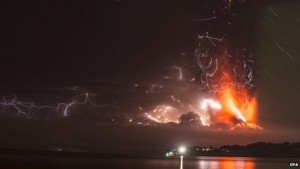
SEVERE THUNDERSTORM WATCH – A severe thunderstorm (damaging winds of 58 miles per hour or more, or 1″ hail in diameter or greater) is likely to develop in your area.
SEVERE THUNDERSTORM WARNING – A severe thunderstorm (damaging winds of 58 miles per hour or more, or hail three-fourths of an inch in diameter or greater) is taking place in your area.
PROTONS – They are particles with a positive charge.
ELECTRONS – They are particles with a negative charge.
STATIC ELECTRICITY – It is a form of electricity that is created when an object has too many electrons, giving it a negative charge.
CHANNEL– The narrow path of ionized air in which the lightning current discharge flows. It is illuminated brightly by the return stroke.
LEADERS – A channel of charged air created by excess electrons in a thunderstorm cloud. A leader reaches from the cloud to the ground below, looking for positive charges.
RETURN STROKE – It’s an electrical charge that travels from the ground to a thundercloud. This return stroke releases tremendous energy, bright light and thunder.
DISCHARGE– The flow of current down the lightning channel that equalizes the charge difference between two regions on opposing charge inside a thunderstorm.
STREAMERS – A channel of charged air created by protons on the ground. They are created when leaders are created and reach from the ground to the sky looking for a leader to connect with.
ARC– A channel of ionized air with electric current flowing through it, usually used to describe those occurring during a fault on an energized power line.
FAULT– A short circuit.
FLASH– Referring to the entire lightning discharge event from beginning to end.
STROKE– Referring tot he flow of current through the lightning channel.
- The movement of rain and ice inside a thundercloud creates an electrical charge, with the negative charge (electrons) forming at the bottom of the cloud and the positive charge (protons) forming at the top.
- A lightning flash is no more than one inch wide.
- Thousands of people are struck by lightning every year.
- Direct lightning strikes are usually fatal.
- What we see as a flash of lightning may actually be four different strokes in exactly the same place, one right after another. That’s why lightning appears to flicker.
- Lightning is a powerful burst of electricity that happens very quickly during a thunderstorm.
- Lightning can occur inside clouds, between clouds and from clouds to the ground.
- Around one quarter of lightning is from cloud to ground.
- Lightning is caused by an electrical charge in the atmosphere that is unbalanced.
- Opposites attract so the negative charge at the bottom of the cloud seeks out a positive charge to connect with.
- When lightning strikes the ground it seeks out the shortest route to something with a positive charge, this might be a tree, a tall building or if they’re very unlucky, a person.
- Most lightning occurs over land rather than oceans, with around 70% of it occurring in the Tropics.
- There are bolts of lightning striking somewhere on Earth every second.
- Lightning strikes usually last around 1 or 2 microseconds.
- Lightning contains millions of volts of electricity.
- The average temperature of lightning is around 36,000°F (20,000 °C ).
- Lightning is usually produced by cumulonimbus clouds that are very tall and dense.
- Lightning can also occur during volcanic eruptions, dust storms, snow storms, forest fires and tornadoes.
- The study of lightning is known as fulminology.
- Astraphobia is the fear of thunder and lightning.
Click Here to see if there are any active warnings in your area.
IF YOU’RE OUTDOORS: Keep an eye at the sky. Look for darkening skies, flashes of lightning, or increasing winds. Lightning often proceeds rain, so don’t wait for the rain to begin. If you hear the sound of thunder, go to a safe place immediately. The best place to go is a sturdy building or a car, but make sure the windows in the car are shut. Avoid sheds, picnic areas, baseball dugouts and bleachers.
If there is no shelter around you, stay away from trees. Crouch down in the open area, keeping twice as far away from a tree as far as it is tall. Put your feet together and place your hands over your ears to minimize hearing damage from thunder. If you’re with a group of people stay about 15 feet from each other. Stay out of water, because it’s a great conductor of electricity. Swimming, wading, snorkeling and scuba diving are not safe. Also, don’t stand in puddles and avoid metal. Stay away from clotheslines, fences, and drop your backpacks because they often have metal on them. If you’re playing an outdoor activity, wait at least 30 minutes after the last observed lightning strike or thunder.
IF YOU’RE INDOORS: Avoid water. It’s a great conductor of electricity, so do not take a shower, wash your hands, wash dishes or do laundry. Do not use a corded telephone. Lightning may strike exterior phone lines. Do not use electric equipment like computers and appliances during a storm. Stay away from windows and doors and stay off porches.
IF SOMEONE IS STRUCK BY LIGHTNING: Call for help. Call 9-1-1 or send for help immediately. The injured person does not carry an electrical charge, so it is okay to touch them.
Make Lightning In Your Mouth Experiment: Here is a great experiment that allows kids to make lightning in their mouth. It’s a great way for them to understand how lightning works.
What’s Lightning Experiment: Here is a great experiment that allows the kids to make lightning. All you need is a balloon and a light bulb!
Make Lightning Experiment: Here is another great experiment that allows the kids to make lightning. This teaches kids about the positive and negative charges and where they come from.
Sticking A Balloon To A Wall Experiment: Here is an experiment that allows the kids to learn about static electricity by sticking a balloon to a wall. This teaches kids about the positive and negative charges and where they come from.
Bend Water Experiment: Here is another static electricity experiment that bends water. This teaches kids about the positive and negative charges and where they come from.
Make Your Hair Stand Up Experiment: Here is yet another static electricity experiment with using a balloon and your hair. This teaches kids about the positive and negative charges and where they come from.
Make Thunder Experiment: This experiment allows kids to make thunder, in a way that allows them to understand how it is made by lightning.
Track A Thunderstorm Experiment: Here is a great way to teach kids how to track a thunderstorm.
Make A Thunderstorm Experiment: Here is a great experiment that shows kids how our weather works. It teaches them how thunderstorms are formed!
Science Fair Project Ideas: Here is a complete list of science fair project ideas. Discover the science behind the weather that impacts us every day.
